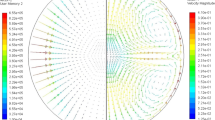Abstract
The results are considered of the earth experiments on growth of high-purity and Ga-doped germanium single crystals 15 mm in diameter and 60 mm in length, which were performed in a Zona-4 “space furnace” under the technological regimes close to those existing in space orbits. It is shown that the use of a magnetohydrodynamic (MHD) factor [weak (0.15–0.2 mT) rotational (400 Hz) magnetic fields] during crystallization of semiconductors by the floating-zone technique is a very promising method for control of dopant distributions and electrophysical properties in a growing crystal. It is shown that in such magnetic fields, the effective coefficient of Ga distribution in Ge decreases by 10%. The shift of the donor-acceptor balance of the residual dopants in a compensated semiconductor during growth with the MHD-stirring of the melt was first established in growth of undoped germanium single crystals. It was also established that magnetic fields produce different effects on the resistivity microinhomogeneity in undoped and doped crystals. The mechanisms of the MHD effect on the properties of the grown crystals are discussed as well as the perspectives of performing analogous experiments aboard spacecrafts. It is predicted that, under the microgravitation conditions, the effects revealed in terrestrial experiments would be more pronounced.
Similar content being viewed by others
References
É. S. Kopeliovich, V. V. Rakov, and N. A. Verezub, Tsvetn. Met. (Moscow), No. 8, 52 (1991).
A. V. Kartavykh, É. S. Kopeliovich, M. G. Mil’vidskii, and V. V. Rakov, Kristallografiya 43(6), 1136 (1998) [Crystallogr. Rep. 43, 1075 (1998)].
A. V. Kartavykh, E. S. Kopeliovich, M. G. Mil’vidskii, and V. V. Rakov, J. Cryst. Growth 205(4), 497 (1999).
M. G. Mil’vidskii, A. V. Kartavykh, E. S. Kopeliovich, et al., Journal of Journals (UNESCO) 2(1), 6 (1998).
A. V. Kartavykh, Kristallografiya 45(6), 2352 (2000) [Crystallogr. Rep. 45, 1024 (2000)].
M. G. Mil’vidskii, N. A. Verezub, A. V. Kartavykh, et al., Kristallografiya 42(5), 913 (1997) [Crystallogr. Rep. 42 (5), 843 (1997)].
M. T. Devdariani, O. V. Pelevin, A. I. Prostomolotov, et al., Preprint No. 516, IPM RAN (Institute for Problems of Mechanics, Russian Academy of Sciences, Moscow, 1992), No. 516, p. 32.
A. B. Kapusta and A. F. Zibol’d, Magn. Gidrodin., No. 1, 77 (1983).
A. B. Kapusta, Magn. Gidrodin., No. 1, 63 (1984).
J. Burton, R. Prim, and W. Slichter, J. Chem. Phys. 21(11), 1987 (1953).
W. C. Johnston and W. A. Tiller, Trans. AIME 221, 331 (1961).
I. V. Barmin, A. V. Egorov, V. N. Kurokhtin, et al., in Proceedings of Joint X European and VI Russia Symposium on Physical Science in Microgravity, St. Petersburg, 1997, Vol. II, p. 325.
I. V. Barmin and A. S. Senchenkov, Fluid Dyn. 29(5), 620 (1994).
A. V. Kartavykh, É. S. Kopeliovich, M. G. Mil’vidskii, et al., Kristallografiya 42(4), 755 (1997) [Crystallogr. Rep. 42, 694 (1997)].
N. S. Rytova, E. S. Yurova, and V. V. Karataev, Fiz. Tekh. Poluprovodn. (Leningrad) 14(10), 1979 (1980) [Sov. Phys. Semicond. 14, 1176 (1980)].
Author information
Authors and Affiliations
Additional information
__________
Translated from Kristallografiya, Vol. 46, No. 1, 2001, pp. 159–164.
Original Russian Text Copyright © 2001 by Kartavykh, Kopeliovich, Mil’vidski\(\overset{\lower0.5em\hbox{$\smash{\scriptscriptstyle\smile}$}}{l} \), Rakov.
Rights and permissions
About this article
Cite this article
Kartavykh, A.V., Kopeliovich, É.S., Mil’vidskii, M.G. et al. Earth optimization of space experiment on growth of germanium by floating-zone technique with the use of rotating magnetic fields. Crystallogr. Rep. 46, 148–153 (2001). https://doi.org/10.1134/1.1343144
Received:
Issue Date:
DOI: https://doi.org/10.1134/1.1343144




